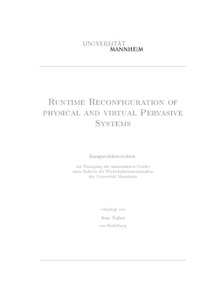|
Runtime reconfiguration of physical and virtual pervasive systems
Naber, Jens
![[img]](https://madoc.bib.uni-mannheim.de/53479/1.hassmallThumbnailVersion/Dissertation_JN.pdf)  Vorschau |
|
PDF
Dissertation_JN.pdf
- Veröffentlichte Version
Download (5MB)
|
|
URL:
|
https://madoc.bib.uni-mannheim.de/53479
|
|
URN:
|
urn:nbn:de:bsz:180-madoc-534798
|
|
Dokumenttyp:
|
Dissertation
|
|
Erscheinungsjahr:
|
2020
|
|
Ort der Veröffentlichung:
|
Mannheim
|
|
Hochschule:
|
Universität Mannheim
|
|
Gutachter:
|
Becker, Christian
|
|
Datum der mündl. Prüfung:
|
17 Dezember 2019
|
|
Sprache der Veröffentlichung:
|
Englisch
|
|
Einrichtung:
|
Fakultät für Betriebswirtschaftslehre > Wirtschaftsinformatik II (Becker 2006-2021)
|
|
Lizenz:
|
 Creative Commons Namensnennung 4.0 International (CC BY 4.0)
Creative Commons Namensnennung 4.0 International (CC BY 4.0)
|
|
Fachgebiet:
|
004 Informatik
|
|
Freie Schlagwörter (Englisch):
|
pervasive systems , visual scripting , runtime reconfiguration
|
|
Abstract:
|
Today, almost everyone comes in contact with smart environments during their everyday’s life. Environments such as smart homes, smart offices, or pervasive classrooms contain a plethora of heterogeneous connected devices and provide diverse services to users. The main goal of such smart environments is to support users during their daily chores and simplify the interaction with the technology. Pervasive Middlewares can be used for a seamless communication between all available devices and by integrating them directly into the environment. Only a few years ago, a user entering a meeting room had to set up, for example, the projector and connect a computer manually or teachers had to distribute files via mail. With the rise of smart environments these tasks can be automated by the system, e.g., upon entering a room, the smartphone automatically connects to a display and the presentation starts. Besides all the advantages of smart environments, they also bring up two major problems. First, while the built-in automatic adaptation of many smart environments is often able to adjust the system in a helpful way, there are situations where the user has something different in mind. In such cases, it can be challenging for unexperienced users to configure the system to their needs. Second, while users are getting increasingly mobile, they still want to use the systems they are accustomed to. As an example, an employee on a business trip wants to join a meeting taking place in a smart meeting room. Thus, smart environments need to be accessible remotely and should provide all users with the same functionalities and user experience.
For these reasons, this thesis presents the PerFlow system consisting of three parts. First, the PerFlow Middleware which allows the reconfiguration of a pervasive system during runtime. Second, with the PerFlow Tool unexperi- enced end users are able to create new configurations without having previous knowledge in programming distributed systems. Therefore, a specialized visual scripting language is designed, which allows the creation of rules for the commu- nication between different devices. Third, to offer remote participants the same user experience, the PerFlow Virtual Extension allows the implementation of pervasive applications for virtual environments. After introducing the design for the PerFlow system, the implementation details and an evaluation of the developed prototype is outlined. The evaluation discusses the usability of the system in a real world scenario and the performance implications of the middle- ware evaluated in our own pervasive learning environment, the PerLE testbed. Further, a two stage user study is introduced to analyze the ease of use and the usefulness of the visual scripting tool.
|
 | Dieser Eintrag ist Teil der Universitätsbibliographie. |
 | Das Dokument wird vom Publikationsserver der Universitätsbibliothek Mannheim bereitgestellt. |
 Suche Autoren in Suche Autoren in
BASE:
Naber, Jens
Google Scholar:
Naber, Jens
Sie haben einen Fehler gefunden? Teilen Sie uns Ihren Korrekturwunsch bitte hier mit: E-Mail
Actions (login required)
 |
Eintrag anzeigen |
|
|
